回族的英文介绍
- 格式:doc
- 大小:27.00 KB
- 文档页数:2
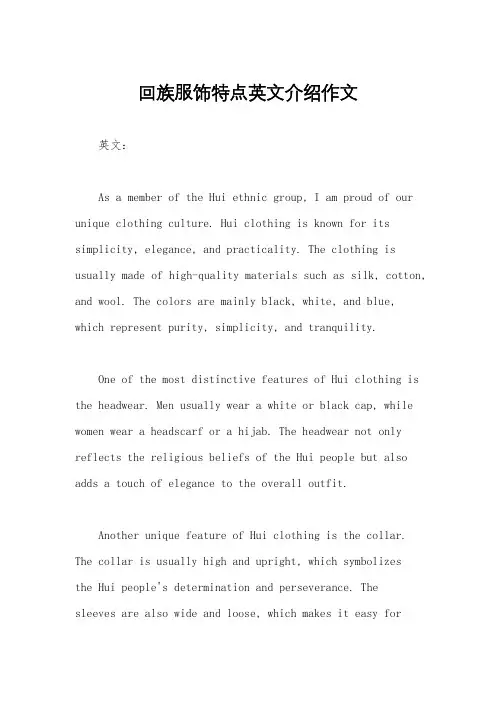
回族服饰特点英文介绍作文英文:As a member of the Hui ethnic group, I am proud of our unique clothing culture. Hui clothing is known for its simplicity, elegance, and practicality. The clothing is usually made of high-quality materials such as silk, cotton, and wool. The colors are mainly black, white, and blue, which represent purity, simplicity, and tranquility.One of the most distinctive features of Hui clothing is the headwear. Men usually wear a white or black cap, while women wear a headscarf or a hijab. The headwear not only reflects the religious beliefs of the Hui people but also adds a touch of elegance to the overall outfit.Another unique feature of Hui clothing is the collar. The collar is usually high and upright, which symbolizesthe Hui people's determination and perseverance. Thesleeves are also wide and loose, which makes it easy forpeople to move and work.In addition to the traditional clothing, Hui people also wear modern clothing that combines traditional elements with contemporary fashion. For example, a Hui woman may wear a long dress with a traditional collar and a modern pattern.Overall, Hui clothing is a perfect blend of tradition and modernity. It not only reflects the cultural heritage of the Hui people but also showcases their creativity and innovation.中文:作为回族人,我为我们独特的服饰文化感到自豪。
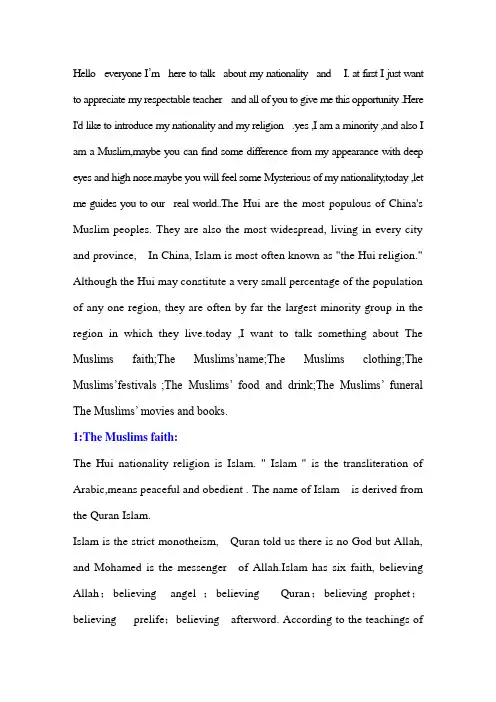
Hello everyone I’m here to talk about my nationality and I. at first I just want to appreciate my respectable teacher and all of you to give me this opportunity .Here I'd like to introduce my nationality and my religion.yes ,I am a minority ,and also I am a Muslim,maybe you can find some difference from my appearance with deep eyes and high nose.maybe you will feel some Mysterious of my nationality,today ,let me guides you to our real world..The Hui are the most populous of China's Muslim peoples. They are also the most widespread, living in every city and province, In China, Islam is most often known as "the Hui religion." Although the Hui may constitute a very small percentage of the population of any one region, they are often by far the largest minority group in the region in which they live.today ,I want to talk something about The Muslims faith;The Muslims’name;The Muslims clothing;The Muslims’festivals;The Muslims’ food and drink;The Muslims’ funeral The Muslims’ movies and books.1:The Muslims faith:The Hui nationality religion is Islam. " Islam " is the transliteration of Arabic,means peaceful and obedient . The name of Islam is derived from the Quran Islam.Islam is the strict monotheism, Quran told us there is no God but Allah, and Mohamed is the messenger of Allah.Islam has six faith, believing Allah;believing angel ;believing Quran;believing prophet;believing prelife;believing afterword. According to the teachings ofIslam, Muslims must practice five lessons, including reading Quran , going to mosque;fast( fast a month, a year ) donation (out of about 1 / 40 of your income to the poor or the mosque ), worship (where the economic and physical conditions allow, everyone need the pilgrimageʒ] to Makkah once in one’s life ). and Every Friday we need to worship together.2:The Muslims’nameThe word" Muslim" is derived from" Islamic", means peaceful, and submission. And all of our names are associated with it .after birth,we would hold a ceremony and A Imam will give us a name ." The name" is also called" Hui name"," the Muslim name". " the name must be written in Arabic. Because" the Koran" is written in Arabic, all the" Muslim's name" are from the Koran, that be used by many Islamic prophets, such as male called" isa", " Yousaf"," Nu sea"," Ali"," Mohamed" and female choice;" Fatima"," Aisha"," Nuha Ya",and so on.the name generally used only for our nationality, symbolic and religious connotation.once getting a Muslim's name,the newborn will become a Muslim.3:h e Muslims’clothing;Hui nationality costume and main symbol is in the head.The characteristics of the Muslim clothing -- men with white cap, with various colors of a woman. The man loves to wear white clothes, women wearblack gowns.Islam advocates of black, white, green.So far the world Muslim still advocating black, white, green.4:The Muslims’festivals['fɛstəvl] ;The most important Folk festivals are: Eid(Eid-ul-Fitr,开斋节)and Corbon(宰牲节)Eid:an annual Muslim festival marking the end of Ramadan, involving the exchange of gifts and a festive meal 。
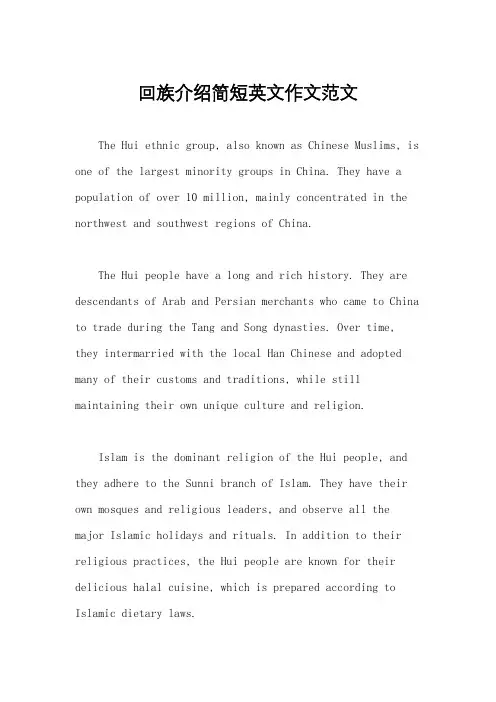
回族介绍简短英文作文范文The Hui ethnic group, also known as Chinese Muslims, is one of the largest minority groups in China. They have a population of over 10 million, mainly concentrated in the northwest and southwest regions of China.The Hui people have a long and rich history. They are descendants of Arab and Persian merchants who came to China to trade during the Tang and Song dynasties. Over time, they intermarried with the local Han Chinese and adopted many of their customs and traditions, while still maintaining their own unique culture and religion.Islam is the dominant religion of the Hui people, and they adhere to the Sunni branch of Islam. They have their own mosques and religious leaders, and observe all the major Islamic holidays and rituals. In addition to their religious practices, the Hui people are known for their delicious halal cuisine, which is prepared according to Islamic dietary laws.The Hui people are also known for their contributionsto Chinese culture and society. Many famous scholars, poets, and artists from the Hui ethnic group have made significant contributions to Chinese literature, music, and art. TheHui people are also known for their contributions to Chinese medicine, with many Hui doctors and healers practicing traditional Chinese medicine and acupuncture.Despite their contributions to Chinese culture and society, the Hui people have faced discrimination and prejudice throughout Chinese history. However, in recent years, the Chinese government has taken steps to promote ethnic harmony and protect the rights of minority groups, including the Hui people.In conclusion, the Hui ethnic group is a fascinatingand important part of China's cultural and religious landscape. Their unique culture, religion, andcontributions to Chinese society make them an integral part of China's rich and diverse heritage.。
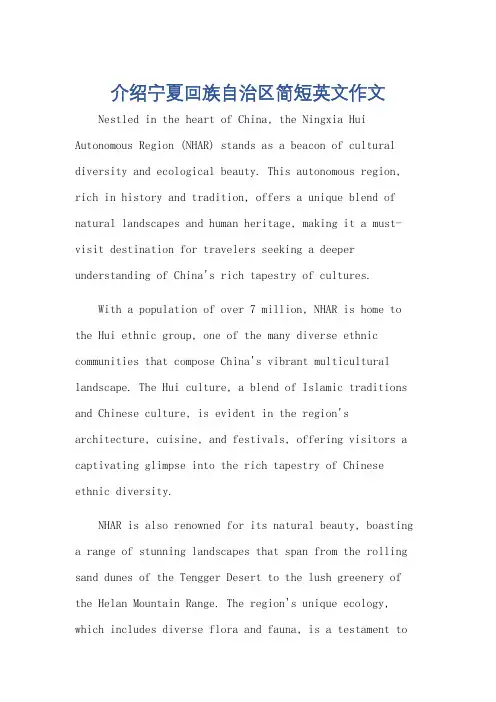
介绍宁夏回族自治区简短英文作文Nestled in the heart of China, the Ningxia Hui Autonomous Region (NHAR) stands as a beacon of cultural diversity and ecological beauty. This autonomous region, rich in history and tradition, offers a unique blend of natural landscapes and human heritage, making it a must-visit destination for travelers seeking a deeper understanding of China's rich tapestry of cultures.With a population of over 7 million, NHAR is home to the Hui ethnic group, one of the many diverse ethnic communities that compose China's vibrant multicultural landscape. The Hui culture, a blend of Islamic traditions and Chinese culture, is evident in the region's architecture, cuisine, and festivals, offering visitors a captivating glimpse into the rich tapestry of Chinese ethnic diversity.NHAR is also renowned for its natural beauty, boasting a range of stunning landscapes that span from the rolling sand dunes of the Tengger Desert to the lush greenery of the Helan Mountain Range. The region's unique ecology, which includes diverse flora and fauna, is a testament tothe harmonious coexistence of humans and nature. Visitors can explore the region's natural wonders through hiking, camping, and other outdoor activities, offering arefreshing break from the hustle and bustle of urban life.In addition to its cultural and natural attractions, NHAR is also known for its economic prowess. The region has emerged as a key player in China's renewable energy sector, particularly in the field of solar power. With its abundant sunshine and vast deserts, NHAR has become a leading producer of solar panels and other renewable energy technologies, contributing to China's efforts in reducing carbon emissions and promoting sustainable development.Moreover, NHAR is home to several cities and towns that offer a glimpse into the region's vibrant urban life. Yinchuan, the capital of NHAR, is a modern city that boasts a thriving economy, rich cultural heritage, and a vibrant nightlife. Other towns and villages in the region offer a glimpse into the traditional rural life of the Hui people, where visitors can experience the charm of rural China and connect with the warmth and hospitality of the local people.In conclusion, the Ningxia Hui Autonomous Region is a treasure trove of cultural diversity, natural beauty, and economic progress. It offers a unique travel experience that allows visitors to delve into the rich tapestry of Chinese culture and connect with the spirit of the Hui people. Whether you are a history buff, a nature lover, or simply seeking a unique travel adventure, NHAR is sure to leave you with memories that last a lifetime.**宁夏回族自治区:中国的璀璨明珠**位于中国心脏地带的宁夏回族自治区(NHAR)是一座文化多样性和生态美景的璀璨明珠。
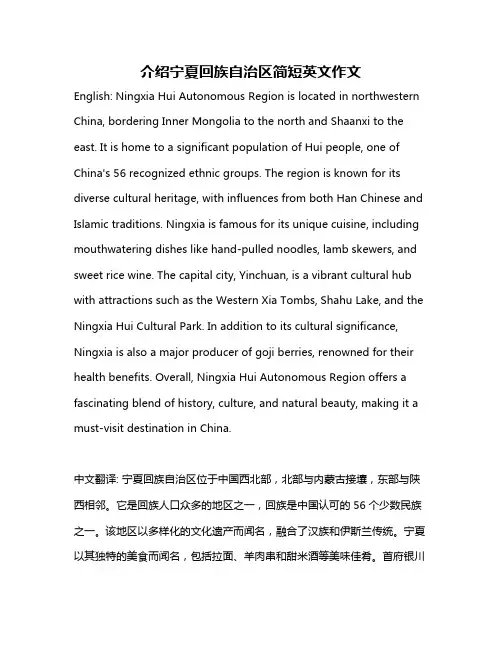
介绍宁夏回族自治区简短英文作文English: Ningxia Hui Autonomous Region is located in northwestern China, bordering Inner Mongolia to the north and Shaanxi to the east. It is home to a significant population of Hui people, one of China's 56 recognized ethnic groups. The region is known for its diverse cultural heritage, with influences from both Han Chinese and Islamic traditions. Ningxia is famous for its unique cuisine, including mouthwatering dishes like hand-pulled noodles, lamb skewers, and sweet rice wine. The capital city, Yinchuan, is a vibrant cultural hub with attractions such as the Western Xia Tombs, Shahu Lake, and the Ningxia Hui Cultural Park. In addition to its cultural significance, Ningxia is also a major producer of goji berries, renowned for their health benefits. Overall, Ningxia Hui Autonomous Region offers a fascinating blend of history, culture, and natural beauty, making it a must-visit destination in China.中文翻译: 宁夏回族自治区位于中国西北部,北部与内蒙古接壤,东部与陕西相邻。
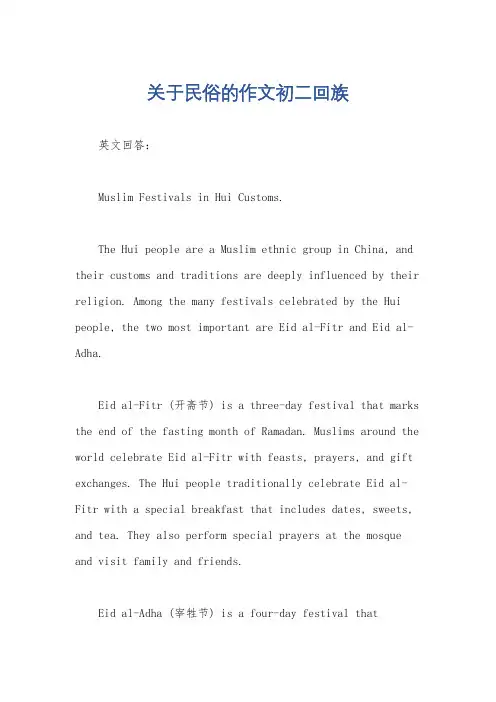
关于民俗的作文初二回族英文回答:Muslim Festivals in Hui Customs.The Hui people are a Muslim ethnic group in China, and their customs and traditions are deeply influenced by their religion. Among the many festivals celebrated by the Hui people, the two most important are Eid al-Fitr and Eid al-Adha.Eid al-Fitr (开斋节) is a three-day festival that marks the end of the fasting month of Ramadan. Muslims around the world celebrate Eid al-Fitr with feasts, prayers, and gift exchanges. The Hui people traditionally celebrate Eid al-Fitr with a special breakfast that includes dates, sweets, and tea. They also perform special prayers at the mosque and visit family and friends.Eid al-Adha (宰牲节) is a four-day festival thatcommemorates the Prophet Abraham's willingness to sacrifice his son Ishmael. Muslims around the world celebrate Eid al-Adha by slaughtering animals and distributing the meat to the poor. The Hui people traditionally celebrate Eid al-Adha by slaughtering sheep and dividing the meat amongtheir family, friends, and neighbors.In addition to Eid al-Fitr and Eid al-Adha, the Hui people also celebrate other Islamic festivals, such as the Prophet Muhammad's birthday (圣纪) and the Night of Power ( ردقلا). These festivals are all important occasions for the Hui people to come together and celebrate their Muslim heritage.中文回答:回族民俗中的穆斯林节日。
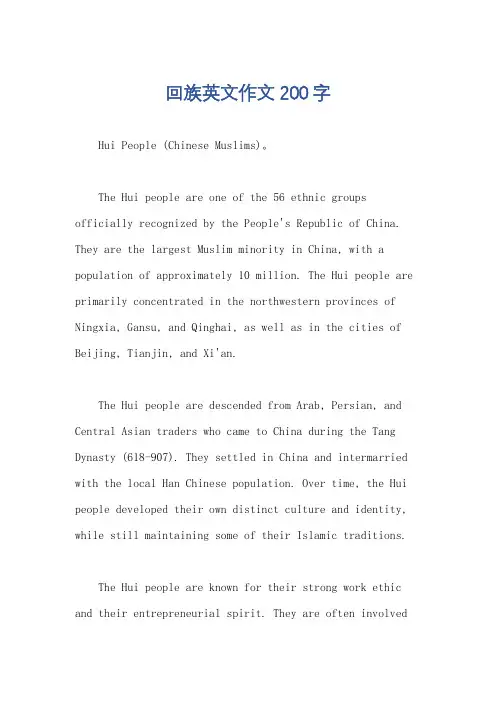
回族英文作文200字Hui People (Chinese Muslims)。
The Hui people are one of the 56 ethnic groups officially recognized by the People's Republic of China. They are the largest Muslim minority in China, with a population of approximately 10 million. The Hui people are primarily concentrated in the northwestern provinces of Ningxia, Gansu, and Qinghai, as well as in the cities of Beijing, Tianjin, and Xi'an.The Hui people are descended from Arab, Persian, and Central Asian traders who came to China during the Tang Dynasty (618-907). They settled in China and intermarried with the local Han Chinese population. Over time, the Hui people developed their own distinct culture and identity, while still maintaining some of their Islamic traditions.The Hui people are known for their strong work ethic and their entrepreneurial spirit. They are often involvedin the food, clothing, and textile industries. The Hui people are also known for their martial arts skills, and many of them have served in the Chinese military.The Hui people have faced some discrimination and persecution in China, but they have also made significant contributions to Chinese society. They have served in high-ranking government positions, and they have played an important role in the development of Chinese culture and society.The Hui people are a proud and resilient people who have made a unique contribution to Chinese society. They are an important part of the Chinese cultural mosaic and they continue to play an important role in the development of China.。
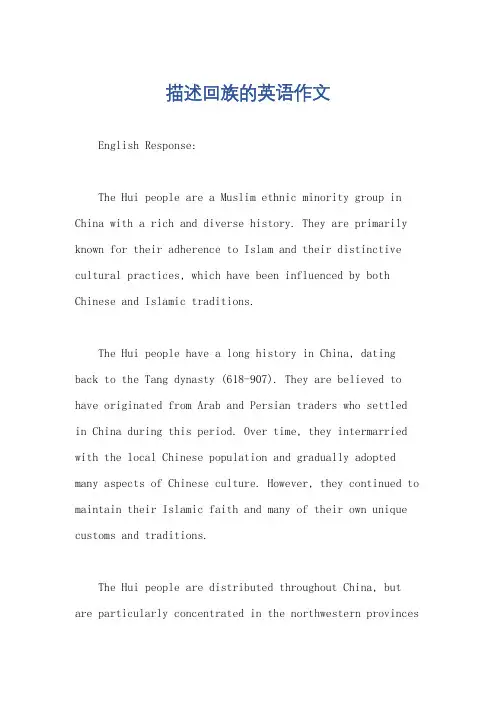
描述回族的英语作文English Response:The Hui people are a Muslim ethnic minority group in China with a rich and diverse history. They are primarily known for their adherence to Islam and their distinctive cultural practices, which have been influenced by both Chinese and Islamic traditions.The Hui people have a long history in China, dating back to the Tang dynasty (618-907). They are believed to have originated from Arab and Persian traders who settledin China during this period. Over time, they intermarried with the local Chinese population and gradually adopted many aspects of Chinese culture. However, they continued to maintain their Islamic faith and many of their own unique customs and traditions.The Hui people are distributed throughout China, but are particularly concentrated in the northwestern provincesof Ningxia, Gansu, and Qinghai. They are also found in significant numbers in Beijing, Tianjin, and other major cities. The Hui people speak a variety of Chinese dialects, as well as their own Hui language, which is a dialect of Mandarin Chinese with some Arabic and Persian influences.The Hui people are known for their strong sense of community and their close-knit family ties. They have arich cultural heritage that includes traditional music, dance, and cuisine. The Hui people are also skilled artisans, and are known for their production of ceramics, textiles, and metalwork.In recent years, the Hui people have faced some challenges related to religious freedom and cultural preservation. However, they have also made significant progress in education and economic development. The Hui people are a vibrant and diverse community that continues to play an important role in Chinese society.Chinese Response:回族是一个生活在中国,信奉伊斯兰教的少数民族。
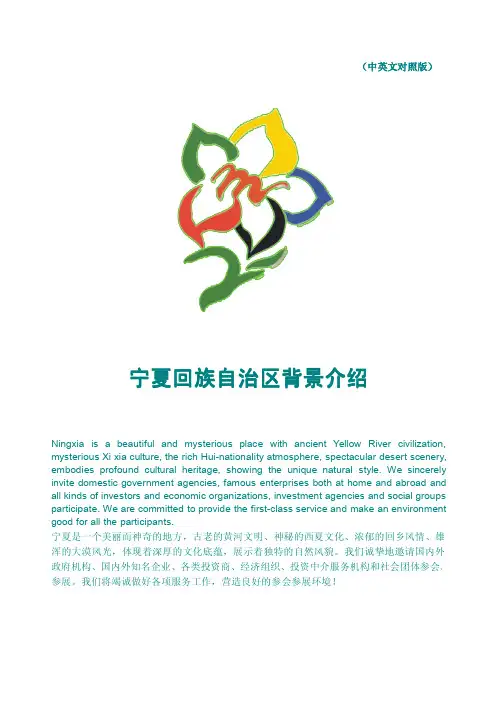
(中英文对照版)宁夏回族自治区背景介绍Ningxia is a beautiful and mysterious place with ancient Yellow River civilization, mysterious Xi xia culture,the rich Hui-nationality atmosphere,spectacular desert scenery, embodies profound cultural heritage,showing the unique natural style.We sincerely invite domestic government agencies,famous enterprises both at home and abroad and all kinds of investors and economic organizations,investment agencies and social groups participate.We are committed to provide the first-class service and make an environment good for all the participants.宁夏是一个美丽而神奇的地方,古老的黄河文明、神秘的西夏文化、浓郁的回乡风情、雄浑的大漠风光,体现着深厚的文化底蕴,展示着独特的自然风貌。
我们诚挚地邀请国内外政府机构、国内外知名企业、各类投资商、经济组织、投资中介服务机构和社会团体参会、参展。
我们将竭诚做好各项服务工作,营造良好的参会参展环境!美丽的宁夏、历史中的宁夏108塔水洞沟遗址贺兰山六盘山西夏王陵月亮湖宁夏区情宁夏是中国五个少数民族自治区之一,是祖国西部一方物华天宝的热土。
宁夏回族自治区地处中国大西北的东部,是中国唯一的省级建制的回族自治区。

回族风俗作文450字左右英文回答:Muslim Culture.The Hui people are a Muslim community with a unique culture and history. They are one of the largest ethnic minority groups in China and have a rich cultural tradition that blends Islamic and Chinese influences.Dietary Restrictions.One of the most distinctive features of Hui culture is their dietary restrictions. As devout Muslims, they adhere to the Islamic dietary laws and abstain from consuming pork and other forbidden foods. This has led to the development of a unique Hui cuisine that is rich in halal meats, vegetables, and spices.Religious Practices.Religion plays a central role in Hui culture. The majority of Hui people are Sunni Muslims and observe the five pillars of Islam: faith, prayer, fasting, charity, and pilgrimage. They have their own mosques and imams and engage in regular religious activities.Traditional Clothing.Traditionally, Hui men wore long robes and caps, while women wore veils and loose-fitting clothing. These traditional garments are still worn on special occasions and are a symbol of Hui identity.Language and Education.The Hui people speak Chinese, but they also have their own distinct dialect known as the Hui language. They place a high value on education and have a long history of producing scholars and intellectuals.Social Customs.Hui culture emphasizes modesty and respect. Social interactions are governed by a set of rules and customs that are based on Islamic principles. They are known for their hospitality and welcoming nature.Festivals and Celebrations.The Hui people celebrate a variety of festivals throughout the year, including Eid al-Fitr, Eid al-Adha, and the Islamic New Year. These festivals are marked by special prayers, feasts, and family gatherings.中文回答:回族风俗。
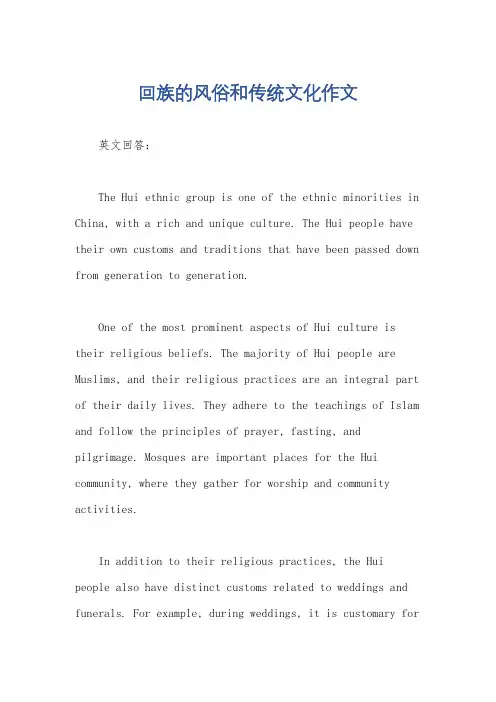
回族的风俗和传统文化作文英文回答:The Hui ethnic group is one of the ethnic minorities in China, with a rich and unique culture. The Hui people have their own customs and traditions that have been passed down from generation to generation.One of the most prominent aspects of Hui culture is their religious beliefs. The majority of Hui people are Muslims, and their religious practices are an integral part of their daily lives. They adhere to the teachings of Islam and follow the principles of prayer, fasting, and pilgrimage. Mosques are important places for the Hui community, where they gather for worship and community activities.In addition to their religious practices, the Hui people also have distinct customs related to weddings and funerals. For example, during weddings, it is customary forthe bride and groom to exchange gifts and for the groom's family to provide a dowry to the bride's family. The wedding ceremony is usually held in a mosque, andtraditional Hui food is served to the guests. Funerals, on the other hand, involve specific rituals and mourning practices, such as wearing white clothes and reciting prayers for the deceased.Another important aspect of Hui culture is their cuisine. Hui cuisine is known for its unique flavors anduse of halal ingredients. Lamb and beef are commonly consumed, and dishes like lamb kebabs, beef noodles, and steamed buns are popular among the Hui people. Hui cuisine also incorporates influences from other regional cuisinesin China, resulting in a diverse and delicious culinary tradition.Furthermore, the Hui people have their own traditional arts and crafts. Calligraphy and painting are highly valued, and many Hui artists have gained recognition for their talent. Embroidery is also a popular craft among Hui women, with intricate designs and vibrant colors. Thesetraditional arts not only showcase the creativity and skill of the Hui people but also serve as a way to preserve their cultural heritage.In conclusion, the Hui ethnic group has a rich and diverse culture that is deeply rooted in their religious beliefs, customs, cuisine, and arts. Their uniquetraditions have been passed down through generations and continue to be celebrated and cherished by the Hui community.中文回答:回族是中国的少数民族之一,拥有丰富而独特的文化。
宁夏回族自治区简介中英文宁夏回族自治区区情简介An Overview of Ningxia Hui Autonomous Region宁夏回族自治区成立于1958年,面积6.64万平方公里,2014年总人口661.5万人,其中回族人口占35.6%,是全国五个少数民族自治区之一。
辖5个地级市,22个县(市、区)。
Founded in 1958, Ningxia covers a total area of 66,400 square kilometers. The total population is 6.615 million in 2014, of which the Hui people accounts for 35.6%. It is one of the five minority autonomous regions in China. It governs five prefecture-level cities and twenty-two counties (or county-level cities, districts).自然状况。
宁夏全境海拔1000米以上,地势南高北低,落差近1000米,呈阶梯状下降。
属典型的大陆性气候,为温带半干旱区和半湿润地区,具有春多风沙、夏少酷暑、秋凉较早、冬寒较长,雪雨稀少、日照充足、蒸发强烈等特点,年平均降水量300毫米左右。
Natural ConditionsThe average altitude is over 1,000 meters, higher in its south than in its north with a stepping-down drop of nearly 1,000 meters. It is typically continental in climate as a temperate semi-arid and subhumid region, as is characterized by windy and sandy spring, short hot summer, early and cool autumn, long and cold winter, sparse snow and rain, abundant sunshine and strong evaporation. The average annual precipitation is approximately 300 millimeters.地理区划。
宁夏回族的风俗作文英文回答:Ningxia Hui Autonomous Region is located in the northwest of China, and it is the only province in China where Muslims occupy the majority of the population. The Ningxia Hui people share many customs with other Hui people in China, but they also have their own unique customs. Here are some of the most famous customs of the Ningxia Hui people:1. 饮食文化。
The Ningxia Hui people have a long history of farming, which is reflected in their diet. They mainly eat wheat, corn, and rice, and they also grow a variety of vegetables and fruits. The Ningxia Hui people are known for their delicious dishes, such as halal noodles, fried noodles, and fried pastries.Hui cuisine (回族菜系) is one of the eight major Chinese cuisines. It is characterized by its use of halal ingredients, such as lamb, beef, and mutton. Hui dishes are often flavored with cumin, chili powder, and other spices. Some of the most famous Hui dishes include:Halal noodles (清真面): These are thin, wheat noodles that are boiled and then served with a variety of toppings, such as meat, vegetables, and eggs.Fried noodles (炒面): These are wide, flat noodlesthat are fried with vegetables, meat, and eggs.Fried pastries (油香): These are deep-fried pastries that are made with flour, water, and oil. They are often filled with meat or vegetables.2. 服饰文化。
介绍回族英语作文Title: The Hui Ethnic Group: A Cultural Portrait。
The Hui ethnic group, one of the 56 recognized ethnic groups in China, is known for its rich cultural heritage and unique traditions. As a member of the Hui community, I take pride in sharing insights into our culture throughthis English essay.Historical Background:The Hui people are descendants of Arab, Persian, and Central Asian Muslim traders who settled in China centuries ago, particularly during the Tang (618-907 AD) and Song (960-1279 AD) dynasties. Over time, they intermarried with Han Chinese and adopted many Chinese customs while preserving their Islamic faith and cultural identity.Culture and Traditions:One of the most distinctive aspects of Hui culture is its adherence to Islam. Mosques, with their elegant minarets and intricate designs, serve as spiritual and communal centers for the Hui community. The call to prayer, known as Adhan, echoes through the streets of Hui neighborhoods, reminding believers of their religious duties.Cuisine:Hui cuisine reflects the fusion of Islamic dietary laws with Chinese culinary techniques. Halal food, prepared according to Islamic guidelines, is a hallmark of Hui gastronomy. Popular dishes include lamb kebabs, hand-pulled noodles, and steamed dumplings filled with savory meat and spices.Language:While the Hui people speak Mandarin Chinese in their daily lives, many also retain knowledge of Arabic or Persian languages, which are used for religious purposesand cultural rituals. This linguistic diversity reflectsthe multicultural heritage of the Hui ethnic group.Festivals:The Hui people celebrate traditional Chinese festivals such as the Spring Festival (Chinese New Year) and the Mid-Autumn Festival, while also observing Islamic holidays like Eid al-Fitr and Eid al-Adha. During these festive occasions, families gather to share meals, exchange gifts, and offer prayers at the mosque.Art and Architecture:Hui art and architecture are characterized by their Islamic motifs and designs. Intricate patterns adorn mosques, homes, and religious artifacts, reflecting the influence of Islamic art on Hui culture. Calligraphy, particularly Arabic script, holds a revered place in Hui artistic expression.Social Customs:Respect for elders and hospitality are deeply ingrained in Hui society. Guests are warmly welcomed into Hui households and treated with generosity and courtesy. Additionally, modesty in dress and behavior is highly valued, in accordance with Islamic teachings on decency and humility.Challenges and Resilience:Despite facing challenges such as discrimination and cultural assimilation, the Hui people have demonstrated remarkable resilience in preserving their cultural heritage. Through education, community activism, and cultural initiatives, Hui individuals and organizations strive to safeguard their identity and promote understanding and harmony among different ethnic groups in China.Conclusion:In conclusion, the Hui ethnic group is a vibrant community with a rich cultural tapestry woven fromcenturies of interaction between East and West. From its Islamic heritage to its culinary delights and artistic expressions, Hui culture continues to thrive and inspire, offering a glimpse into the diversity and complexity of China's multicultural landscape. As a member of the Hui community, I am proud to share our story with the world and celebrate the unique contributions of our people to the tapestry of human civilization.。
回族服饰特点英文介绍作文英文:The traditional attire of the Hui ethnic group, known as "Hui Zu Fu Shi" (回族服饰) in Chinese, carries a rich cultural heritage and distinctive features that reflect the unique identity of the Hui people. Let me delve into the characteristics of Hui ethnic clothing.Firstly, one prominent aspect of Hui attire is its modesty and elegance. Traditionally, both men and women wear loose-fitting garments that cover the body fully, adhering to Islamic principles of modesty. For instance, Hui men often wear a "Dopiao" (多袍), a long robe with wide sleeves, paired with loose trousers, while women don the "Qipao" (旗袍), a long dress with a high collar andintricate embroidery, often complemented by a headscarf or veil.Moreover, the colors and patterns in Hui clothing aresymbolic and meaningful. Dark colors such as black, navy blue, and dark green are commonly preferred, symbolizing humility and solemnity. Additionally, intricate geometric patterns and floral motifs are often embroidered or woven onto the fabric, signifying harmony with nature and the divine.Another distinctive feature is the incorporation of cultural elements from both Han Chinese and Islamic traditions. This fusion of styles results in a unique blend of aesthetics. For example, while the silhouette of the clothing may resemble traditional Han attire, the use of specific fabrics, patterns, and accessories such as the "Muslim hat" (回族帽子) or "turban" (头巾) distinctly identifies it as Hui clothing.Furthermore, Hui attire is not only worn on special occasions but also as everyday wear, reflecting thecultural significance attached to clothing within the Hui community. It serves as a means of cultural expression and identity, fostering a sense of belonging and pride amongits wearers.In conclusion, Hui ethnic clothing is a testament tothe rich cultural heritage and diversity of China. Its modesty, elegance, symbolic elements, and fusion oftraditions make it a unique and cherished aspect of Hui culture.中文:回族服饰是回族人民传统的着装方式,体现了丰富的文化遗产和独特的特点,让我来深入了解一下回族服饰的特点。
介绍宁夏回族自治区简短英文作文全文共5篇示例,供读者参考篇1Ningxia: The Colorful Place with Friendly PeopleHi friends! Today I want to tell you all about a really cool place called Ningxia. It's a region in the northwest part of China. Get ready to learn some fun facts!Ningxia is home to lots of different cultures and people. The Hui people are one of the main groups that live there. They are Muslim, so they follow the religion of Islam. Many of the buildings in Ningxia have beautiful designs with arches and patterns that come from Islamic architecture. The Hui people have their own language too, called Hu'ihu! Isn't that a neat name?The landscape in Ningxia is really pretty. There are tall mountains, deep canyons, and even a huge desert called the Tengger Desert. The sand in the desert is yellow and it stretches out as far as you can see! Sometimes you can see camels walking through the desert. That's how people used to travel across it a long time ago before there were cars and planes.Even though Ningxia has a lot of dry, sandy areas, there are also places with water. The Yellow River runs through the region. It's one of the biggest rivers in the world! People use the river water to grow crops like rice, corn, and wheat. There are also some lakes and wetlands in Ningxia that are home to cool animals like black storks. Those are big birds with cool patterns on their feathers.Ningxia gets pretty cold in the winter with temperatures dropping below freezing. But in the summer, it's scorching hot! So the people have to dress very warmly in the winter but can wear light, thin clothing when it's summertime. No matter the season, you'll see a lot of bright, vivid colors everywhere you look in Ningxia. The buildings are painted beautiful shades of blue, yellow, green and more. Even nature is colorful, with red rock formations and rainbow-colored mineral deposits in some areas.Speaking of colorful, the food in Ningxia is so delicious and full of spices and flavors! The Hui people love to use lamb in their cooking. Some popular dishes are nang, which is a type of flat bread, and the yogurt-based drink called shuangni. For snacks, you can get candies and nuts covered in sweet or salty coatings. Everything tastes amazing!The people of Ningxia love celebrating their culture through festivals and holidays. One of the biggest is the Hui New Year, which happens in the early spring. There are huge feasts, dancing, and other fun traditions. Another important holiday is Eid al-Fitr, which marks the end of Ramadan, a sacred month of fasting for Muslims. During Eid, families get together and kids receive gifts and treats. Doesn't that sound like fun?There are so many other neat things about Ningxia I could tell you, but I'm running out of space. I hope you learned some cool new facts about this unique region of China. Maybe you can plan a visit someday to experience the amazing food, see the colorful buildings, and meet the friendly Hui people. Ningxia is waiting for you!篇2Here's a short essay introducing Ningxia Hui Autonomous Region in English, written in a tone suitable for elementary school students. The essay is around 2,000 words long.A Fascinating Place: Ningxia Hui Autonomous RegionHave you ever heard of Ningxia Hui Autonomous Region?It's a really cool place in northwestern China, and today, I'm going to tell you all about it!Ningxia is a relatively small region, but it's packed with interesting things to see and learn about. It's known for its diverse culture, beautiful landscapes, and rich history.One of the things that makes Ningxia special is that it's home to many Hui people. The Hui are an ethnic group in China who practice Islam. They have their own unique customs, traditions, and way of life. In Ningxia, you'll find lots of beautiful mosques, where the Hui people gather to pray and celebrate their faith.Another cool thing about Ningxia is its amazing natural scenery. There are towering mountains, like the Helan Mountains, which are perfect for hiking and taking in the fresh air. You can also find vast deserts, like the Tengger Desert, where you can go on exciting camel rides and see the stunning sand dunes.Ningxia is also known for its delicious food. One of the most famous dishes is called "Shuan Rou," which is a flavorful lamb dish. The Hui people are experts at making this tasty meal, and you'll find it in many restaurants across the region.If you're interested in history, Ningxia has a lot to offer. The region has been an important part of China for centuries, and you can still find ancient relics and ruins from different dynasties.One of the most famous historical sites is the Western Xia Imperial Tombs, which were built over 1,000 years ago!Now, let me tell you about some of the fun things you can do in Ningxia. One popular activity is visiting the Yellow River Wetlands. This is a beautiful area where you can see all kinds of birds and other wildlife. You can even go on a boat ride and float along the river!Another cool place to visit is the Shahu Kou Village. This is an ancient village that's been around for hundreds of years. You can walk through the narrow streets and see how people used to live back then. It's like stepping into the past!Of course, no trip to Ningxia would be complete without trying some of the local crafts. The Hui people are skilled at making things like embroidery, pottery, and silk products. You can watch them work and even try your hand at some of these traditional crafts.Overall, Ningxia is a fascinating place with a rich culture, stunning natural beauty, and a long history. Whether you're interested in exploring ancient ruins, trying new foods, or just enjoying the great outdoors, Ningxia has something for everyone.So, what do you think? Would you like to visit Ningxia someday? I hope this essay has given you a taste of what this amazing region has to offer. Who knows, maybe you'll even pick up a few words of the Hui language while you're there!篇3Ningxia: The Colorful Land of the Hui PeopleHi friends! Today I want to tell you about a really cool place in China called Ningxia. It's officially called the Ningxia Hui Autonomous Region. Have you ever heard of it before?Ningxia is located in the northwest part of China. It's right between the Yellow River and the great Tengger Desert. The Yellow River is one of the most important rivers in Chinese history. The Tengger Desert is a huge sandy desert with tall sand dunes that look like golden waves!The weather in Ningxia is pretty dry and desert-like, but it still has four seasons just like we do. The summers can get really hot, up to 40°C! That's super hot. In the winter it's cold and sometimes snowy. But no matter the season, you'll probably need to wear sunscreen because of the strong sun.One of the coolest things about Ningxia is that it's an autonomous region for the Hui people. The Hui are one of thelargest ethnic minorities in China. They are mostly Muslims who follow the Islamic religion. Over 1/3 of the people living in Ningxia are Hui.The Hui people have their own culture, customs, food, clothing styles, and even architecture that is different from the Han Chinese majority. For example, Hui women often wear colorful headscarves and long dresses. The men might wear little round caps called dopa. A lot of Hui buildings have decorated arches, carved wood, and pretty colored tiles.Speaking of food, the Hui cuisine in Ningxia is simply delicious! It combines Chinese and Islamic flavors. Some popular dishes are crispy fried chicken, hand-pulled noodles, flatbreads, and all kinds of lamb and beef dishes. Everything is seasoned with cumin, peppers, and other yummy spices. After eating, you can relax with a cup of strong black tea.One of my favorite Hui snacks is niangao, which are chewy sticky rice cakes. During holidays like the Hui New Year and Eid al-Fitr, families eat special foods like jingzhenghongshao, which is a stew with potatoes, lamb, carrots and apricots. Yum!Now let me tell you about some cool places to visit in Ningxia. In the capital city Yinchuan, there's an old Muslim quarter filled with mosques, markets, and restaurants. TheNanguan Mosque is over 600 years old - can you imagine that?? Its minarets look like twisting helices reaching up into the sky.Just outside Yinchuan is Western Xia Imperial Tombs. It's an archaeological site with ancient tombs and ruins from the Western Xia dynasty that ruled the area 1,000 years ago. You can see underground tomb chambers decorated with murals and sculptures. So fascinating!Another awesome place is Shahu Lake. It's a giant salt lake where you can literally walk on the water! The super salty water is so dense that you float right on top of it. There are these crazy salt crystal formations all over too. Shahu Lake looks like something from another planet.Finally, I have to mention the Tengger Desert. This vast desert takes up a huge portion of Ningxia. Hiking up the giant sand dunes is tough work but you get amazing views. At night, the desert sky is filled with more stars than you could ever imagine. Some dunes sing - yes, sing! When the wind blows over them they make a strange humming sound. Isn't that wild?Well, that's all I have to say about amazing Ningxia for now! I really want to visit there someday and experience the Hui culture. I'd love to ride a camel through the desert, sample all the tasty food, and see the colorful mosques and markets. Hopefully youlearned some cool new things about this special region of China. Let me know if you have any other questions!篇4My Home Province: Ningxia Hui Autonomous RegionHello, my name is Xiao Ming, and I'm a student in Ningxia Hui Autonomous Region. Today, I want to tell you about my beautiful home province in northwest China. It's a place with lots of history, delicious food, and amazing scenery. Let me take you on a journey to explore Ningxia!Ningxia is a relatively small province, but it's packed with incredible sights and culture. It's located in the northwestern part of China, bordering Gansu, Shaanxi, and Inner Mongolia. The capital city is Yinchuan, which means "Silver River" in Chinese. It got this name because of the Yellow River that flows through the city, shimmering like silver under the sun.One of the most famous landmarks in Ningxia is the Western Xia Imperial Tombs. These tombs belonged to the rulers of the Western Xia Dynasty, which ruled over parts of northwestern China from the 11th to 13th centuries. The tombs are like underground palaces, with intricate carvings and paintings onthe walls and ceilings. It's amazing to think that people built such beautiful structures so long ago!Another incredible place in Ningxia is the Shahu Lake. It's a huge, beautiful lake surrounded by sandy beaches and rolling hills. The water is so clear and blue that it almost looks like a giant mirror reflecting the sky above. Many people come to Shahu Lake to swim, fish, and have picnics. It's a great place to relax and enjoy nature.Speaking of nature, Ningxia is also home to the Yellow River Wetland Nature Reserve. This massive wetland is a paradise for all kinds of birds and other wildlife. You can see rare species like the red-crowned crane, which is a beautiful bird with a bright red crown on its head. The wetland is full of tall reeds, winding rivers, and peaceful ponds – it's like a secret garden waiting to be explored!Now, let's talk about the people of Ningxia. The majority of the population is made up of the Hui ethnic group, which is one of the largest Muslim communities in China. The Hui people have their own unique culture, language, and traditions. One of the most famous things about Hui culture is the delicious food!Ningxia is known for its flavorful halal cuisine, which follows Islamic dietary laws. Some of the most popular dishes includeYangrou Chuar (grilled lamb skewers), Niunai Xianzi(hand-pulled noodles with beef and milk), and Guozhuang (steamed dumplings). My personal favorite is the Niunai Xianzi –the noodles are so chewy and delicious, and the broth is rich and creamy. Yum!During festivals and celebrations, the Hui people love to gather and enjoy traditional performances like Huaer (a type of folk singing) and Shamanistic dances. These performances are full of vibrant colors, lively music, and incredible dancing. It's so much fun to watch and be part of the festivities!One of the biggest events in Ningxia is the Hui New Year, also known as the Aqiqah Festival. During this time, families get together to enjoy feasts, exchange gifts, and participate in various cultural activities. The streets are decorated with colorful lanterns and banners, and there's a feeling of joy and celebration in the air.As you can see, Ningxia is a truly special place. It's a melting pot of different cultures, traditions, and natural wonders. From the ancient tombs to the stunning wetlands, there's always something new and exciting to discover. I feel so lucky to call this province my home, and I hope that one day, you'll have the chance to visit and experience its beauty for yourself.篇5My Big Adventure to Ningxia!Hi friends! I went on a super cool trip to a place called Ningxia during my summer vacation. It's in the northwest part of China. Let me tell you all about my amazing adventure!Ningxia is famous for being the home of the Hui people. The Hui are one of the largest ethnic minority groups in China. They practice Islam, just like people in countries like Egypt and Saudi Arabia. The Hui have lived in Ningxia for hundreds of years.On the first day, we went to the Nanguan Mosque in the capital city of Yinchuan. It's one of the oldest and biggest mosques in all of China! The mosque was built way back in the 1600s. It has beautiful Arabic writing and designs all over the walls and ceilings. I felt like I was in an ancient palace!While we were there, we saw lots of Hui people dressed in colorful traditional clothes. The men wore little round hats and long robes. The women had on bright flowery dresses and headscarves. They looked so pretty and unique. Some of the old men had long white beards too which was really cool.After the mosque, we drove out to the countryside to see the sand dunes. Ningxia is right next to the huge Tengger Desert. Wewent on a cool dune buggy ride over the golden sandy dunes. It was like being on a roller coaster in the desert! I felt like I was in a movie scene from Lawrence of Arabia or something.The sand was so fine and soft between my toes. Our guide told us that some parts of the desert have "singing sand dunes." The sand makes a weird ringing, squeaking noise when the wind blows over it. Unfortunately we didn't get to hear it, but I thought that was fascinating!The next day, we visited the Shuidonggou Mummies site. You'll never believe what they found buried there - a whole bunch of ancient mummies! About 30 years ago, archaeologists discovered over a hundred mummies that were around2,000-4,000 years old. The cool thing is that their bodies, clothes, and even their hair are still perfectly preserved from thousands of years ago.The mummies were ethnic minorities from the Silk Road times. Some of them had red hair and long noses. The arid desert conditions basically turned the corpses into mummies naturally over time. It was equal parts creepy and awesome seeing those ancient mummified people up close. Definitely aonce-in-a-lifetime experience!Later, we went to the Xixia Tombs which was the cemetery for the royal family of the Western Xia Dynasty from the 1000s. They built these massive underground tombs shaped like pyramids for their kings and queens. The largest tomb has over 600 rooms underground! I don't know how they constructed something so huge and complicated back then without modern tools.Our last stop was the amazing Shapotou Railway that travels right through the heart of the Tengger Desert. It's one of the most difficult railway lines in the world due to the shifting sands. Armies of workers have to constantly monitor and remove sand from the tracks.We even got to ride part of the railway through the desert to a small desert village. Gigantic sand dunes rose up on both sides of the train as we chugged through the vast ocean of golden sand. Every once in a while, the wind would blow sand across the tracks in front of us. It felt like we had been transported to another planet!That's a little glimpse into my awesome trip to Ningxia. There was so much cool history, culture, and breathtaking scenery everywhere we went. I'll never forget riding through the desert on that train or seeing those ancient mummies up close. Ifyou ever get the chance to visit Ningxia, you absolutely have to go! It's a fascinating, one-of-a-kind place.。
回族概况:With a population of 8,603,000 in 1990, the Hui are the most populous of China's Muslim peoples. They are also the most widespread, living in every city, province, and region of China, as well as in 2,308 of China's 2,372 counties. In China, Islam is most often known as "the Hui religion." Although the Hui may constitute a very small percentage of the population of any one region, they are often by far the largest minority group in the region in which they live.回族不吃猪肉:Nonconsumption of pork and mosque attendance also serve as ethnic identifiers, as does circumcision where it occurs. The Hui are often called "Chinese Muslims," even though they are regarded as a national minority rather than a religious community. One can be Han Chinese and Christian but not Han Chinese and Muslim.清真:The words qing zhen (pure and true) are often associated with Hui life, in reference to all Islamic ideals. These words are often placed on the signs of Hui establishments and on products in which Islamic ideals of purity are supposedly maintained: restaurants, food stores, bakeries, ice cream stores, candy wrappers, mosques, incense packages, and Islamic literature. In the case of food, qing zhen means that the food is free of contamination by pork and other unclean foods and is ritually purified.东北和西北回人的文化、饮食等区别There is great variability in the religious conservatism of the Hui. In northwest China the Hui are very conservative and are growing more so. There, leaders and parents have placed a great deal of emphasis on religious education, especially the study of the Quran. Many of these parents also question the value of studying Chinese language, history, and other subjects in public schools. Conservatism has also increased in other respects: in some places smoking and the consumption of alcohol are now prohibited where they were once common. In contrast, in northeastern China many Hui smoke, drink, and eat pork when away from home.Muslim compatriots to earn our living making snacks for a long time. Saying "Hui 'two knives,' 'eight rope'." "Two knives" means the sale and the sale of beef and mutton cut cake, "8 to justice" is Diaodanhangshang hawkers Pan said. Hui snacks formed many generations, the family name and names of the specific brand, such as "pie week," and "air of Ma," "South to Shun." Muslim chef Chu Ming Cheung connected to superb cuisine and unique way as Beijing halal food cooks leader. Hui there are nearly 200 kinds of snacks, such as unexploded belly, tea, cut cake, Beijing is an important component of the cuisine.The Muslim people have earned a living by making snacks.It is worth mentioning that there are characteristics industry Muslim camel trip. Old, the Beijing Hui camel trip for all operators, as Beijing's transport industry have made great contributions. 1922, Niujie camel trip in the Sugar Association founder of the alley Zhen Yu primary schools, the revitalization of the education of Hui contributed its part.Hui enthusiasts have numerous national education Xuanna pay for the effort. Enthusiastic about education, the pursuit of progress Wang Haoran imam put forward to educate the "get rid of poverty and ignorance", and in the Niujie founded by the middle of the first primary.In addition to the revitalization of the national education mullah Wang Haoran, there are still many areas Xuanna Hui celebrities, such as: patriotism educators Masongting imams, Muslim envoys oz-China mullah, and carving masters such as Liang Yan Yu. Hui join martial arts with wrestling practice, the performance of minority-specific hard-working and industrious and brave spirit. People with "more than five" to commend the Niujie wrestling reception. First, many people love wrestling. Second, good camp flutter flutter of several houses. Third, more celebrity wrestling. Fourth, more private跤field. 5, sports master more. Niujie impact on the Chinese-style wrestling throughout the country, a famous three-ADB Yonglu, such as white-zhen and others. Hui is the throwing of traditional folk sports, particularly prevalent in the Niujie area. Throwing of a fight with Qingshi made Tongsuo shape of the stone, cast iron replaced later by the stone. The action of throwing drills are throwing high, knifing, throwing a lotus leaf, then high, then leaves, the name: support beams, Leong Che fan, knifing Genzhu, dismantling leaves, leaves, etc. mouth. Throwing a can of physical fitness training in music and寓special civil cultural and sports activities, to the folk culture Tianxie Xuanna a heavy hint of color.EC built in the Liao and 14 years (AD 996) of the existing Niujielibaishi our most complete history, the oldest Islamic temple, has 1,000 years of history. Temple ranked by order of the Zhaobi, Shimen, Mochizuki floor, worship Temple, Bang-Ke Lau, Beiting, composed of the Chamber, the grand scale, a solemn幽深for the quality of China's ancient architecture. Niujielibaishi its long history and magnificent architecture world-famous, and every year a large number of domestic and foreign guests to the Muslim pilgrimage here, enhance the friendship between the people of all countries to strengthen friendly exchanges between the Muslims.。
回族概况:With a population of 8,603,000 in 1990, the Hui are the most populous of China's Muslim peoples. They are also the most widespread, living in every city, province, and region of China, as well as in 2,308 of China's 2,372 counties. In China, Islam is most often known as "the Hui religion." Although the Hui may constitute a very small percentage of the population of any one region, they are often by far the largest minority group in the region in which they live.回族不吃猪肉:Nonconsumption of pork and mosque attendance also serve as ethnic identifiers, as does circumcision where it occurs. The Hui are often called "Chinese Muslims," even though they are regarded as a national minority rather than a religious community. One can be Han Chinese and Christian but not Han Chinese and Muslim.清真:The words qing zhen (pure and true) are often associated with Hui life, in reference to all Islamic ideals. These words are often placed on the signs of Hui establishments and on products in which Islamic ideals of purity are supposedly maintained: restaurants, food stores, bakeries, ice cream stores, candy wrappers, mosques, incense packages, and Islamic literature. In the case of food, qing zhen means that the food is free of contamination by pork and other unclean foods and is ritually purified.东北和西北回人的文化、饮食等区别There is great variability in the religious conservatism of the Hui. In northwest China the Hui are very conservative and are growing more so. There, leaders and parents have placed a great deal of emphasis on religious education, especially the study of the Quran. Many of these parents also question the value of studying Chinese language, history, and other subjects in public schools. Conservatism has also increased in other respects: in some places smoking and the consumption of alcohol are now prohibited where they were once common. In contrast, in northeastern China many Hui smoke, drink, and eat pork when away from home.Muslim compatriots to earn our living making snacks for a long time. Saying "Hui 'two knives,' 'eight rope'." "Two knives" means the sale and the sale of beef and mutton cut cake, "8 to justice" is Diaodanhangshang hawkers Pan said. Hui snacks formed many generations, the family name and names of the specific brand, such as "pie week," and "air of Ma," "South to Shun." Muslim chef Chu Ming Cheung connected to superb cuisine and unique way as Beijing halal food cooks leader. Hui there are nearly 200 kinds of snacks, such as unexploded belly, tea, cut cake, Beijing is an important component of the cuisine.The Muslim people have earned a living by making snacks.It is worth mentioning that there are characteristics industry Muslim camel trip. Old, the Beijing Hui camel trip for all operators, as Beijing's transport industry have made great contributions. 1922, Niujie camel trip in the Sugar Association founder of the alley Zhen Yu primary schools, the revitalization of the education of Hui contributed its part.Hui enthusiasts have numerous national education Xuanna pay for the effort. Enthusiastic about education, the pursuit of progress Wang Haoran imam put forward to educate the "get rid of poverty and ignorance", and in the Niujie founded by the middle of the first primary.In addition to the revitalization of the national education mullah Wang Haoran, there are still many areas Xuanna Hui celebrities, such as: patriotism educators Masongting imams, Muslim envoys oz-China mullah, and carving masters such as Liang Yan Yu. Hui join martial arts with wrestling practice, the performance of minority-specific hard-working and industrious and brave spirit. People with "more than five" to commend the Niujie wrestling reception. First, many people love wrestling. Second, good camp flutter flutter of several houses. Third, more celebrity wrestling. Fourth, more private跤field. 5, sports master more. Niujie impact on the Chinese-style wrestling throughout the country, a famous three-ADB Yonglu, such as white-zhen and others. Hui is the throwing of traditional folk sports, particularly prevalent in the Niujie area. Throwing of a fight with Qingshi made Tongsuo shape of the stone, cast iron replaced later by the stone. The action of throwing drills are throwing high, knifing, throwing a lotus leaf, then high, then leaves, the name: support beams, Leong Che fan, knifing Genzhu, dismantling leaves, leaves, etc. mouth. Throwing a can of physical fitness training in music and寓special civil cultural and sports activities, to the folk culture Tianxie Xuanna a heavy hint of color.EC built in the Liao and 14 years (AD 996) of the existing Niujielibaishi our most complete history, the oldest Islamic temple, has 1,000 years of history. Temple ranked by order of the Zhaobi, Shimen, Mochizuki floor, worship Temple, Bang-Ke Lau, Beiting, composed of the Chamber, the grand scale, a solemn幽深for the quality of China's ancient architecture. Niujielibaishi its long history and magnificent architecture world-famous, and every year a large number of domestic and foreign guests to the Muslim pilgrimage here, enhance the friendship between the people of all countries to strengthen friendly exchanges between the Muslims.。